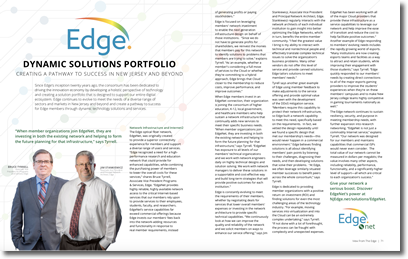Creating a Pathway to Success in New Jersey and Beyond
Since Edge’s inception twenty years ago, the consortium has been dedicated to driving the innovation economy by developing a holistic perspective of technology and creating a solution portfolio that is designed to support our entire digital ecosystem. Edge continues to evolve to meet the needs of a diverse range of sectors and markets in New Jersey and beyond and create a pathway to success for Edge members through dynamic technology solutions and services.
Network Infrastructure and Internet2
The Edge optical fiber network, EdgeNet, was originally created to provide a superior connectivity experience for members and support a diverse range of users and services. “Edge recognized a need for a high-performance research and education network that could provide for enhanced capabilities, while combining the purchasing power of members to lower the overall costs for these services,” shares Bruce Tyrrell, Associate Vice President Programs & Services, Edge. “EdgeNet provides highly reliable, highly available network access to the critical Internet-based services that our members rely upon to provide services to their employees, students, faculty, and researchers. EdgeNet’s service capabilities far exceed commercial offerings because Edge invests our members’ fees back into the network-adding resources and functionality in response to real member requirements, instead of generating profits or paying stockholders.”
Edge is focused on leveraging members’ network investment to enable the next generation infrastructure design on behalf of those institutions. “Since we do not have to generate profits for shareholders, we reinvest the monies that members pay for this network to identify solutions to problems that members are trying to solve,” explains Tyrrell. “As an example, whether a member’s considering a full move of services to the Cloud or whether they’re committing to a hybrid approach, Edge brings that Cloud closer to the membership to reduce costs, improve performance, and improve outcomes.”
When Edge members invest in an EdgeNet connection, their organization is joining the consortium of higher education, K-12, local government, and healthcare members who help sustain a network infrastructure that continually adds new services to meet their specific business needs. “When member organizations join EdgeNet, they are investing in both the existing network and helping to form the future planning for that infrastructure,” says Tyrrell. “EdgeNet has exposure to all levels of our members’ technical organizations and we work with network engineers daily on highly technical designs and solution solving. We work with network managers to deliver these solutions in a supportable and cost-effective way and build long-term strategies that will provide positive outcomes for each institution.”
Edge is constantly evolving to meet the requirements of their members, whether by negotiating deals for services that lower overall members’ expenses or investing in the network architecture to provide specific technical capabilities. “We continuously look at how we can improve the quality and reliability of the network and we solicit members on ways to enhance our service offering,” says Jim Stankiewicz, Associate Vice President and Principal Network Architect, Edge. Stankiewicz regularly interacts with the network architects of each individual institution to gain insight into better optimizing the Edge Networks, which in turn, benefits the entire member community. “I feel the greatest value I bring is my ability to interact with technical and nontechnical people and effectively translate complex technical issues to solve the organization’s business problems. Many other vendors do not offer this level of service and provide canned solutions; Edge tailors solutions to meet members’ needs.”
Tyrell says another great example of Edge using member feedback to make adjustments to the service offering and provide optimal value was seen with the development of the DDoS mitigation service. “Members require this capability to protect their network infrastructure, so Edge built a network capability to meet this need, specifically based on the requirements. In fact, we vetted the design repeatedly until we found a specific design that met our membership’s needs—this would never happen in a commercial environment.” Edge believes finding solutions is all about identifying members’ pain points by listening to their challenges, diagnosing their needs, and then developing solutions that solve their problems. “At Edge, we often leverage similarly situated member successes to benefit peers across the whole consortium,” says Tyrrell.
Edge is dedicated to providing member organizations with a positive return on investment (ROI) and finding solutions for even the most challenging areas of the technology industry. “For example, moving services into virtualization and into the Cloud can be an extremely complex undertaking,” says Tyrrell. “If not done with a lot of forethought, the process can be fraught with complexity and unexpected expenses. EdgeNet has been working with all of the major Cloud providers that provide these infrastructure as a service capabilities to leverage our network and help improve the ease of transition and reduce the cost to help facilitate positive outcomes.” Another example of Edge responding to members’ evolving needs includes the rapidly growing world of esports. “Many institutions are now creating esports teams and facilities as a way to attract and retain students, while improving their engagement with those students,” says Tyrrell. “Edge quickly responded to our members’ needs by creating direct connections to all of the major esports gaming providers to improve the students’ experiences when they’re on these members’ campuses and to make New Jersey college teams highly competitive in gaming tournaments nationally as well.”
The Edge network continues to sustain resiliency, security, and purpose in meeting membership needs, with further expansion into research networking. “EdgeNet is not just a commodity Internet service,” explains Tyrrell. “Our network was designed for our members and maintains capabilities that commercial ISPs would never even consider. The total value of our network cannot be measured in dollars per megabits; the value involves many other aspects, including reliability, performance, functionality, and a significantly higher level of support—all which are critical to each organization’s success.”
Cybersecurity
Cybersecurity remains a primary concern among Edge members, with cases of ransomware, malware, and cryptomining continuing to threaten organizations. To combat these dangers, EdgeSecure aims to provide members with the expertise, resources, and tools needed to keep up with the evolving security landscape and protect their users and data. “EdgeSecure provides high level, knowledgeable resources to members who otherwise could not afford that level of expertise,” says Jeremy Livingston, Edge’s Associate Vice President, Security Solutions Development and Chief Information Security Officer. “We offer competitive pricing on some of the most sought after security tools and services that are available in the market today, and this portfolio continues to evolve based on the needs of our members.”
Comprehensive security practices often look to be costly and unachievable, but EdgeSecure aims to offer an optimal level of security through a shared services model. “Institutions are often easy targets and they do not have the in-house capabilities to defend themselves,” says Livingston. “We look for ways to harden an organization’s networks and systems against attacks, while staying within their budget. Finding the right balance between connectedness and security is also essential, so institutions can still effectively share knowledge, but in a safe and secure way.”
Threats to an organization can be costly and breaches continue to grow in size and scale. “When you calculate the threat to an organization, determine what the risk level is, and put a cost associated with that risk, Edge can often provide solutions that will completely mitigate that cost for a fraction of what the actual risk would have caused,” explains Livingston. “The average breach in the U.S. today is around $8.3 million. Having a proper security strategy in place can help prevent you from becoming part of the statistic.”
When meeting with a member institution, Edge will help the organization understand their current risk level on their existing systems. “Upon determining current risk level, we can help members set appropriate security controls and spending levels to minimize those risks,” says Livingston. “The EdgeSecure line of business provides both solutions as well as software tools to help mitigate the risk. Edge offers everything from DNS cleansing services, advanced in point protection, remote security operations center (SOC), and monitoring capabilities. We also offer the in-house capabilities of our virtual chief information security officers (CISOs), who can provide security assessment, advisement, and virtual CISO services.”
A CISO plays an essential role in IT leadership, balancing information security, risk, and solving general business challenges, but not every organization has the ability to hire a CISO full-time. EdgePro vCISO services are designed to fill that gap and give members access to true CISO-level talent at an affordable cost. Livingston is among the group of six highly-experienced vCISO resources available to member organizations. “The virtual CISO line provides a high level of security expertise and experience for a fraction of the cost of hiring a full-time CISO,” says Livingston.
As with all Edge solutions, member insight and feedback is vitally important to further developing the services provided and ensuring all organizations receive maximum value. Livingston maintains an active connection to the security community of practice and gathers suggestions and recommendations from the wider group. “There’s no single solution that fits every organization or every vulnerability across the board,” explains Livingston. “Edge works with an institution to pinpoint accurate solutions to their unique challenges, explain how these solutions work in easy-to-understand terms, and customize a strategy at the best cost available.”
One of the important cybersecurity projects on the horizon is the shared security operation center (SOC) initiative, which will provide all Edge members access to world-class monitoring and incident response capabilities at an affordable cost. “We have several exciting initiatives in the pipeline,” says Livingston. “We want members to know there are many services and benefits available at no cost to them. We are also here as a resource if they have questions and I am always happy to connect a member organization with other contacts if I am not able to help. Edge is becoming a hub of innovation and solution in the security realm and we are here to help members find the information and solutions they need.”
Events and Community
Edge provides opportunities for members to engage with the consortium and with their peer community to help drive their strategic objectives and priorities forward. Through EdgeEvents, Edge hosts annual and seasonal conferences, forums, and thematic events including EdgeCon, the CxO Exchange, and the Women Leaders in Technology Professional Network. “Everything involved in putting on an Edge event, from initial conception to realization, is held together by the clear purpose of providing our members with access to optimal technology solutions and the learning and professional development required to implement them,” says Nancy Zimmerman, Edge’s Executive Director for EdgeEvents and Print Communications. “This defined sense of purpose is the recurring theme that ties all of our various events together. Edge events sources presenters, content, and brings together professionals and technology providers from around the region and beyond to share ideas, grow professionally, and discover solutions to today’s challenges.”
Zimmerman says this mission is particularly true with EdgeCon, the annual conference Edge holds in early January. “The highly-rated conference, attended by more than four hundred Edge members and partners, is cited as one of the best regional events to advance organizational strategy, professional development, and as a way for members to maintain and grow their professional network.”
Since inception, Edge has filled the networking and learning needs of the higher education IT community and fills members’ need for tangible, direct dialogue with trusted peers and a trusted partner. “Edge events evolved out of the desire of our members to gather with their peers, to have an opportunity to share ideas and best practices with people they can relate to and learn from, and to gain the benefit of a professional network,” says Zimmerman.
Creating a successful event requires considerable time and effort and many member organizations lack the resources to put toward planning and executing. “At Edge, we take a long-term view outlook,” shares Zimmerman. “Rather than assessing an event’s worth solely based on the number of participants or direct post-event sales impact, we measure the value more holistically. Our events and programs target ways to help build skills and explore issues that all of our members face, such as business system modernization, student retention, the future of work, and more. EdgeEvents provide the opportunity for our members to explore technology solutions vetted through a trusted partner.”
Zimmerman says events can establish a genuine emotional connection with customers for proactive and direct engagement, especially as the need for ongoing, meaningful interactions with customers is rising. “Our event strategy focuses on fostering customer participation and allowing customers to ‘take ownership’ of the event touchpoint. This approach increases relevance and brings the Edge experience to life in unique and memorable ways.” To further enhance the value of EdgeEvents, the consortium fosters open dialogue with members and provides tools to gather honest feedback and suggestions. “EdgeXchange is a prime example of how Edge collects member input,” says Zimmerman. “Whether the communication is URL or IRL (in real life), we ask members to join the conversation and provide quantitative and qualitative feedback after every event and program. We take the feedback to heart and source future programming and/or identify emerging themes for future events.”
“Edge events evolved out of the desire of our members to gather with their peers to have an opportunity to share ideas and best practices with people they can relate to and learn from, and to gain the benefit of a professional network.”
NANCY ZIMMERMAN
Executive Director for EdgeEvents & Print Communication, Edge
Migrating to the Cloud
Digital transformation, including the journey to the Cloud, is on the top of many organization’s agendas, since the ability to gain efficiencies, lower costs, and scale to meet business needs is critical. Building a cloud strategy can be a significant challenge, especially with the vast array of services and applications available. “The cloud is a critical component of transformation and offers multiple models to support every requirement,” says Gregg Chottiner, Vice President for Technology Advancement and Chief Information Officer, Edge. “Since the Cloud is scalable, small pilots can be implemented to test the waters and adjust as needed.” EdgeCloud was designed to help members build a Cloud strategy and ensure they are leveraging the Cloud-based services to best meet the needs of their organization.
EdgeCloud aims to simplify the process for members and provide access to resources and partnerships with leading Cloud service providers. “Edge recognizes that organizations need to gain efficiencies and support business requirements with static staff complements and often flat or shrinking budgets. A popular myth states migration to the Cloud is simply a ‘lift and shift.’ However, the Cloud offers many solutions that must be evaluated to determine the best solution for the organization.”
Chottiner says leveraging the Cloud allows a transformational shift from CapEx (capital expenditure) to OpEx (operational expenditure), enabling organizations to better plan their budgets and reallocate resources to more strategic projects. Plus, members gain a winning combination of affordable pricing for products and services, along with proven thought leadership of the Edge staff. “Many members are moving their virtual machines (VM) to Amazon Web Services (AWS) to reduce data center and infrastructure costs. Edge has formed strategic partnerships with leading companies that offer innovative solutions. For EdgeCloud, our partnership with AWS has provided several members with access to Cloud services and eliminated egress fees, saving significant funding. In addition, we have partnered with VMware to allow members to purchase VMware licenses at significant discounts.”
The planned obsolescence of technology is a cost driver and continues to not only consume IT budgets, but requires staff time to administer the products. EdgeCloud presents multiple Cloud solutions that provide opportunities for organizations to gain efficiencies and reduce costs. “The Cloud offers multiple models and delivery systems that maximize ROI,” says Chottiner. “Organizations can reduce or eliminate the need to continuously refresh or replace on-premise and capitalized technology solutions. “EdgeCloud provides a compelling solution set, allowing organizations to obtain advanced cloud products and services, while reducing the need for expensive on premise infrastructures. Funds that traditionally had been allocated for refreshing technology can be reallocated for more strategic projects. The Edge team has Cloud architects that can design creative solutions that enhance services, reduce costs, and improve security.”
Edge regularly sponsors workshops, conferences, and seminars to provide members with access to top technology trends and information. These events also create opportunities for the members to share their comments and experiences with the larger group and give Edge vital insight into the challenges member organizations are facing. With this feedback, Edge is able to further shape their solution portfolio and effectively meet the needs of the Edge community.
Edge employs a systematic approach for solving an organization’s pain points that leverages the understanding of the institution’s current and future business requirements and applying extensive knowledge of the technology landscape. “Once an organization’s business requirements are understood, the Edge team can research our extensive catalog of strategic partners and architect solutions that complement the member’s environment and budget,” says Chottiner. “Edge has the ability to evaluate many solutions, research their relevance to the members, and establish strategic partnerships that provide aggressive pricing and support.”
EdgeCloud products and services support a broad range of requirements and offer solutions that an institution can implement quickly to support their digital transformation journey. In looking ahead, Chottiner says many organizations are identifying and selecting software as a service (SaaS) solutions to replace legacy on-premise applications. “The flexibility and continued evolution of SaaS solutions are making this model a game changer,” says Chottiner. “This transformation eliminates traditional system administration roles and allows these staff members to focus on more strategic projects. SaaS solutions simplify infrastructure architectures, which yield reductions in infrastructure costs and offer a favorable total cost of ownership (TCO).” Going forward, EdgeCloud will continue to grow and offer valuable resources and guidance to Edge members as they look to increase agility and reduce costs—allowing an organization to shift focus from data center management to driving their core business initiatives forward.
“EdgeCloud provides a compelling solution set, allowing organizations to obtain advanced cloud products and services, while reducing the need for expensive on-premise infrastructures. Funds that traditionally had been allocated for refreshing technology can be reallocated for more strategic projects.”
GREGG CHOTTINER
Vice President for Technology Advancement & Chief Information Officer, Edge
Digital Transformation & Education Technologies
Higher education is currently experiencing a significant shift through digital transformation initiatives, driven by globalization and commoditization. According to Christopher Markham, Vice President for Information Technology at Edge, globalization has fully impacted higher education because of online learning, allowing students to become consumers of higher education. “Most colleges and universities used to only compete with one another regionally, but now this scope is quickly expanding,” shares Markham.” To keep pace with these trends, Edge can help bridge the gap between the tactical and strategic value of IT. “Edge is a fixture within the higher education community. We’re a part of the family and we have the breadth and depth of technology expertise and experience that can add value to the entirety of an organization’s technology program and online learning. Within Edge’s wheelhouse, we have over two hundred years of chief information officer (CIO) experience, combined with an extensive background largely in digital transformation.”
In his role, Markham has helped many member institutions conduct information technology assessments. “We recently completed a 360-degree assessment of the entire technology program, including business processes, for an Edge member,” says Markham. “We explored ten different domains in the institutional technology program that span the entire student lifecycle, and provided them with a roadmap for digital transformation.”
To achieve a successful outcome of digital transformation, an institution must have organizational change management and business process modeling. “Without modeling at play, you are not approaching the culture of the institution systematically in a way that puts each stakeholder at the center of the mission,” explains Markham. “Secondly, without the business process modeling, an organization lacks authentic business science that is needed to achieve digital transformation—the formula is a combination of culture and business science.” Data-informed decision-making (DIDM) is also important part of the digital transformation framework, especially in higher education. Institutions can use data to help guide decisions and build a deeper understanding of their students and staff. In addition, gathering key business insights and achieving IT efficiency can be achieved by implementing information technology service management (ITSM). “ITSM works conceptually as a framework that guides an institution’s journey through maturation and handles incidents and customer requests,” says Markham.
With institutional effectiveness as the driving force, Edge delivers solutions that aim to help institutions provide the highest levels of support and services throughout the student lifecycle. Specifically, members can leverage fractional CIO services, where an Edge CIO augments an organization’s leadership team to ensure technology is leveraged efficiently and effectively and supports the institution’s mission and vision. Through these CIO services, members can streamline operations and improve the overall experience for students, faculty, and staff.
Edge solutions, including EdgePro and EdgeMarket, are designed to optimize TCO, while increasing ROI for technology spend. “TCO has an annual direct cost and a multi-year appropriated cost,” explains Markham. “There is also a direct cost associated with labor and professional development to stay current with advancing technology. In addition, there is an economic low, referred to as the law of comparative advantage. This concept comes into play for most higher education organizations that cannot afford high cost competitive technologies or recruiting top talent to implement and maintain those technologies. Edge can help streamline these costs in a predictive way so institutions can outsource the management and acquisition of these technologies. Using services like EdgePro can help an organization lower their total investment over time, both in the technology and the professional development needed to support the new solutions.”
Technology continues to shape the entire academic enterprise by revealing new opportunities and pushing institutions to adapt and grow. “Technology is a disruptor, an accelerator, and an expectation of the modern student,” says Markham. “The digital footprint now exists along every aspect of the student lifecycle; from the time they are recruited, through the time when they become an alumni donor to the institution. Because of this trajectory, organizations must empower their chief executive for information technology by setting an expectation for a digital strategy, as well as providing the executive support for digital transformation.”
Consortium Buying and eProcurement
As many institutions may have experienced, the procurement process required to purchase IT solutions and services can often be daunting and costly. EdgeMarket simplifies and expedites the procurement process, while providing access to innovative technology at an affordable price. Using this service, organizations can identify, prioritize, and acquire the technologies and services that they need to support their ongoing digital transformation. “EdgeMarket is the procurement arm of Edge, responsible for conducting competitive procurements for the solutions and services that our members need, and making those solutions and services readily available for our members to easily acquire,” says Dan Miller, Director Cooperative Pricing Systems, EdgeMarket. “As a state-authorized cooperative pricing system, EdgeMarket provides our participants with great leverage in the marketplace, and that power translates directly into lower prices, added value, and advantageous terms.”
The comprehensive scope of EdgeMarket solutions places an emphasis on a full service approach and understanding of member’s needs. “Edge itself was formed for the purpose of providing members with focus, leverage, and service—initially for high-speed and reliable research and education network backbone and services,” says Miller. “This initial foundation naturally led Edge to expand the consortium’s scope to include the negotiation of contracts for an increasingly broad array of technologies and related services. EdgeMarket, both as a co-op and as a team of well-equipped procurement professionals, embodies the commitment of Edge to be our members’ premier technology partner.”
The solutions available through EdgeMarket are designed to cost-effectively satisfy member needs, while producing beneficial results. “Even before we start discussing ROI of any solution with a member organization, we ask two important questions,” explains Miller. “An organization must explore, ‘why are we doing this procurement’ and ‘how will the solution make us better?’ To assist in this process, Edge will be introducing an outcomes-driven approach to procurements wherein stakeholders will be guided to determine the positive, measurable outcomes that a new technology or service will help members achieve their goals. By focusing on outcomes, we can ensure that our procurements—and our members’ investments—produce optimal results.”
EdgeMarket is a nexus for technology procurement and will expand this role as the new EdgeMarket Portal evolves in scope and depth. “We regularly interact with leaders and practitioners in both IT and purchasing,” shares Miller. “We are also working more closely with our vendors to create greater visibility for their solutions and even greater value for our members. Furthermore, with the collaborative tools that EdgeMarket now has, we will be engaging our members’ stakeholders—key executives, department managers, and end users and their respective peers in other member organizations—in meaningful planning, prioritization, and procurement activities. The idea here is to create great value through a highly collaborative and very efficient process that is focused on doing the right things, at the right time, and in the best possible way.”
To further enhance the value of EdgeMarket and the solutions available, Edge regularly gathers input from members and the education community on the challenges they continue to face and where technology can help further propel their initiatives. “Feedback is baked into the DNA of our highly collaborative approach to planning and procurement,” says Miller. “Our EdgeMarket Portal provides numerous ways for our members to communicate their needs, questions, and concerns, and we are always connecting with members through conversations, presentations, and workshops.”
Miller says members will have many new opportunities to participate in planning and procurement activities as Edge works to expand the catalog of solutions and broaden the support and impact throughout the full lifecycle of technology investments. “We have an opportunity to make EdgeMarket the most responsive, collaborative, and effective co-op in the country. Edge believes that technology procurement should not just be viewed as transactional. This process has the potential to be transformational by elevating the focus from ‘what’ is being procured to ‘why’ (outcomes) and ‘how’ (collaboration). By shifting the focus, we will create the greatest value…together.”
From the beginning, Edge has designed their solutions and services to meet the unique needs of a diverse range of member communities. As new challenges and opportunities arise, Edge will continue to expand their dynamic technology solution portfolio and access to advanced networking to help fuse new collaborations, elevate learning, and drive member success.








